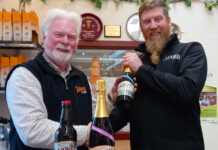Glasgow outlet The Finnieston has gin at its heart. Dave Hunter reports

THE launch of Glasgow gin and seafood bar The Finnieston was a big deal for parent company Kained Holdings.
When it opened its doors in 2011, the outlet – which in November was named SLTN’s Gin Bar of the Year, in association with Schweppes – was, admits Kained director Graham Suttle, “about moving into the big boys’ world”.
Kained, founded in 2007 by Suttle and fellow directors Scott Arnot and Mo Clark, had already established Lebowskis bars in Glasgow and Edinburgh. But The Finnieston would be a move into a more sophisticated restaurant and cocktail bar.
The Argyle Street unit, which had most recently been the Russian Cultural Centre, began life as a drovers’ inn in the 1800s and the Kained team was keen to return some of the venue’s former glory to the space, as well as carry forward the dedication to local produce established in the Lebowskis units.
There’s loads of Scottish gins, but what’s the story behind them? We look for the underdog.
“Scotland’s well-known for its beautiful seafood,” Suttle told SLTN.
“It’s almost unrivalled. If we already celebrated local produce why not celebrate Scotland’s proudest [food], and that’s the seafood.
“The idea of gin and seafood went really well because the lightness of the flavours of the seafood goes really well with the different herbaceous and botanical notes of gin.
“You talk about lemon, pepper and these different botanicals in gin, but then you also talk about lemon and pepper and other botanicals when it comes to seasoning seafood.
“So it was a natural mix for us.”
Designed to be a more high-end proposition than its nearby sister venue, The Finnieston would focus on the best Scottish seafood as well as a strong list of spirits, wines and cocktails with a particular focus on gin.
And right from the start, the venue set out its gin credentials; The Finnieston’s first drinks list included a Martini menu and 20 different gin and tonic serves, in addition to its cocktail list.


In 2018, as the Kained group has grown to nine venues, The Finnieston offer has continued to evolve to feature more than 50 different gins and a selection of tonics and other mixers that includes some homemade tonics and tinctures.
Suttle said that, when choosing new gins for the back-bar (the range is reviewed every quarter) locality and the story behind the brand is crucial.
And if a particular gin is produced by an independent, craft distiller, then so much the better.
He explained: “There’s loads of Scottish gins out there, but what’s the story behind them?
“We look for honesty, and we look for the underdog, the little guy.
“We know we’ve got a very desirable shop window for products, and if we can give people a forum to be able to display their products in a high-end cocktail bar we love the fact we can do that. We’d rather see a ton of local brands up there than tons of big brands.
“So if that’s our part in helping the Scottish drinks industry move forward we’re more than happy to do that.”
Every gin has a job to do. There’s no point in having a dusty bottle on the back-bar.
That being said, every bottle on the gantry has to earn its place, and that means including it in a suitable serve – whether that’s a particular style of Martini, pairing with the right tonic or mixer or working well in a cocktail.
“Every gin on our back-bar has a job to do,” said Suttle.
“There’s no point having a dusty bottle on the back-bar. Every gin has to have a place on your menu.”
Choosing gins and creating serves is a team effort, with bartenders from The Finnieston and Kained’s other outlets working together to experiment with different flavour combinations.
Landing on just the right serve is essential, said Suttle, as it’s important that when customers want to try a new gin, the team can recommend a serve that is perfectly suited to that particular spirit.
Staff training is also an important part of this, and each member of staff receives induction training when they join the venue, as well as quarterly refresher training and regular visits from brand reps.
Suttle said: “Gin’s got subtlety in all of its flavours. So [staff] need to understand the differences in gin and, as part of our training, we make it very clear why we’re picking the serves we pick and why we garnish the way we garnish.
“That forms part of their initial training, but then it becomes part of that feedback from them, where they say ‘well I’ve actually tried it with such and such and it works really well’.
“So it’s best practice and it’s learning from them as much as they’re learning from [us].”
I think gin will become more regional; distilleries will be more reflective of the areas they’re in.
While it was The Finnieston that clinched SLTN’s Gin Bar title last year, the group’s passion for the spirit extends beyond the award-winning Glasgow bar and eatery.
As part of a new venture in St Andrews, Kained is set to introduce its own gin.
It’s not only a big move for the company, it’s an endorsement of the gin category in Scotland.
“Because of the accessibility of gin – gender-wise, age-wise – it crosses every barrier, and bartenders love it,” said Suttle.
“I think gin will become more regional; the microdistilleries will be more reflective of the cities and areas they’re in, and people will become more loyal to those specific ones.
“And I think that’s good for the industry.”























